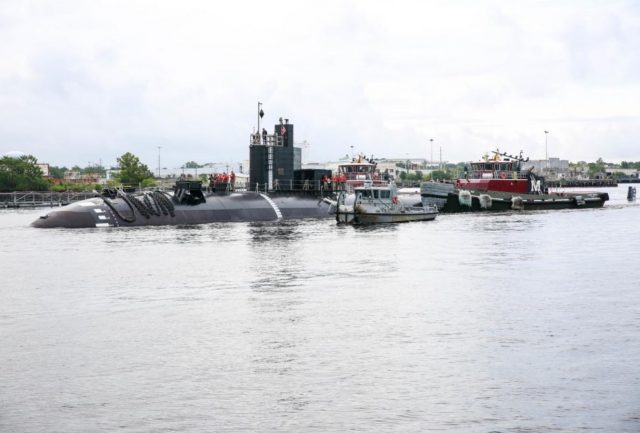
The US Navy’s newest moored training ship USS San Francisco (SSN 711) was towed down to Charleston, South Carolina, on August 16, after completing its conversion work at Norfolk Naval Shipyard (NNSY).
San Francisco will serve as a modern training platform for sailors at the Nuclear Power Training Unit (NPTU) in Charleston, joining MTS La Jolla (MTS 701) which completed its conversion at NNSY in November 2019.
Converting San Francisco required separating the hull into three sections, removal and recycling of the center hull section, and adding three new sections. The new hull sections arrived from General Dynamics Electric Boat via barge. NNSY craned hull sections, averaging 700 tons, into the dock and attached them to San Francisco.
The two moored training ship conversions were the closest NNSY has come to new ship construction since the 1950s. Even more extensive than La Jolla, San Francisco’s conversion marks one of the largest submarine projects of any type in the shipyard’s history.
“Congratulations and thank you to the project team, ship’s force and all our partners involved in coming together as one team to accomplish this massive undertaking,” said Shipyard Commander Captain Dianna Wolfson. “This is a great recognition our service to the Fleet extends beyond active vessels to include these vital training platforms for preparing the sailors operating our nation’s warships for the next several decades.”
“San Francisco’s transformation from an operational fast-attack submarine to a moored training vessel is an investment in the navy’s future,” said San Francisco Commanding Officer Captain Daniel Caldwell. “It’s remarkable to consider just how many Sailors will become proficient in their duties of fleet operation thanks to the dedicated efforts of everyone who supported San Francisco throughout all phases of conversion planning and execution these past six years.”
Throughout the conversion, the project team leveraged lessons learned from La Jolla on a variety of jobs ranging from piping installation to component outfitting to tank restoration. A challenge in the early goings of converting La Jolla was outfitting a new, empty compartment module at NNSY. As a major project improvement for San Francisco, a plan was developed to have a fully-equipped module delivered to the shipyard, providing a savings of more than 10,000 mandays.
Innovations supporting the project team included implementing a cold cut hull cut process, installing several hatch enclosures to improve submarine access for both personnel and equipment, pre-testing of the diesel generators using temporary systems to expedite final testing, and deploying a new scaffolding system to improve worker safety during the vessel’s 34 months in dry dock. This scaffolding system has since become widely used at NNSY.
Once down at Charleston, work on San Francisco will continue into early next year when the conversion is officially completed and the vessel is ready for unrestricted training.
“This project has definitely been a marathon rather than a sprint, but the project team has kept up its endurance as we near the finish line,” said Project Superintendent Charles Brock. “Given the extensive work required, it’s taken a lot of effort and teaming not only within every department in the shipyard but with all nuclear-capable shipyards, both public and private, and all naval nuclear laboratories to get the ship tested and ready for tow. We were excited to see the future MTS 711 head down the river to finish the last of its testing and ultimately fulfill its new mission.”
Last month the shipyard successfully completed an incline experiment for San Francisco, a test performed when significant naval architectural changes are made to vessels. After being moved off the pier, test data determined the vessel’s lightship weight and center of gravity, both critical to stability characteristics and ensuring a safe tow to Charleston.
San Francisco and La Jolla are replacing the former submarines ex-Sam Rayburn (MTS 635) and ex-Daniel Webster (MTS 626), originally commissioned in 1964 and in use as training platforms for the past three decades.


























